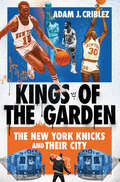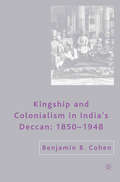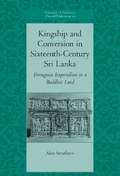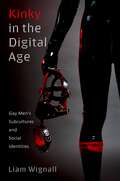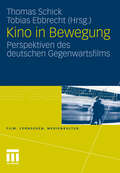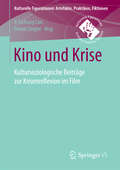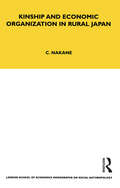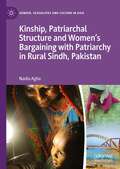- Table View
- List View
Kinetic Beauty: The Philosophical Aesthetics of Sport (Ethics and Sport)
by Jason HoltSport aesthetics is an important but often marginalized field in the philosophy of sport. Kinetic Beauty offers a comprehensive, principled, pluralist introduction to the philosophical aesthetics of sport. The book tackles a wide variety of issues in the philosophical aesthetics of sport, proposing a five-level analysis that coordinates extant scholarship on the same conceptual map, reveals gaps in the literature, and motivates a fresh perspective on stubborn debates and novel topics in the field (for example, the aesthetic experience of athletes, aesthetic biases in sport, the paradox of sport fiction, and whether dance can be sport). This is an excellent resource for professors and students in the philosophy of sport, sport aesthetics, general aesthetics, and the philosophy of art. It is also a fascinating read for those working in kinesiology, sport studies, philosophy, art, and aesthetics.
Kinetic Beauty: The Philosophical Aesthetics of Sport (Ethics and Sport)
by Jason HoltSport aesthetics is an important but often marginalized field in the philosophy of sport. Kinetic Beauty offers a comprehensive, principled, pluralist introduction to the philosophical aesthetics of sport. The book tackles a wide variety of issues in the philosophical aesthetics of sport, proposing a five-level analysis that coordinates extant scholarship on the same conceptual map, reveals gaps in the literature, and motivates a fresh perspective on stubborn debates and novel topics in the field (for example, the aesthetic experience of athletes, aesthetic biases in sport, the paradox of sport fiction, and whether dance can be sport). This is an excellent resource for professors and students in the philosophy of sport, sport aesthetics, general aesthetics, and the philosophy of art. It is also a fascinating read for those working in kinesiology, sport studies, philosophy, art, and aesthetics.
King Kong On 4th Street: Families And The Violence Of Poverty On The Lower East Side (Institutional Structures Of Feeling Ser.)
by Jagna Wojcicka SharffThis book chronicles an ethnographic teams involvement over a span of fifteen years with the people of a poor, largely Puerto Rican neighborhood in New York City. Jagna Sharff focuses on a group of families who live within a radius of a few blocks of her storefront office, especially the children who come first to interact with the team. She contrasts her teams initial observations of how people grapple with daily life with the residents expressed hopes and dreams in a community lacking jobs but rife with underground activities. Through lively and interconnected stories, she traces over time the fate of the neighborhood and the outcomes for individual children and adults during an era when the local and national policy of the war on poverty was transmuted into a war against the poor. The books lyrical, cinematically vivid style makes it appealing both for college social science courses and for the general public. }In King Kong on 4th Street, Jagna Sharff chronicles an ethnographic teams involvement over a span of fifteen years with the people of a poor, largely Puerto Rican neighborhood in New York City. Anchoring her observations in field notes, she recounts the joys, fears, and disappointments of daily life as well as the drama of large events. Arson, the murder of a popular local teenager, the mobbing of a grocery store as an act of retribution for his deathall are projected onto a canvas of shifting local and national policies toward poor people and neighborhoods.Sharff provides new insights into gender and family roles, how adaptations to available resources from the welfare state may shape the membership of households, and how children may be trained for specific adult roles that will advance the familys well-being. She also reveals how the underground economy, particularly the commerce in drugs whose profits are realized outside of the neighborhood, undermines neighborhood-wide solidarity and sends people scrambling against one another for jobs in the quasi-licit and illicit sector. Following the lives of a number of families into the next generation, Sharffs ethnographic team documents how external political decisions that change the war on poverty into a war on the poor affected them. Paramilitary sweeps of the neighborhood, in tandem with gentrification and declining social services, produce severe dislocations and relocation to homeless shelters, welfare hotels, and prisons. But the reality described is not all grim.The books vivid style shows that life is more than grim reality. People get real pleasure from raising children and taking part in the human drama around them. Kinfolk, real and fictive, keep each other afloat and reconnected to new neighborhoods and opportunities, including that of upward mobility through religious conversion. Adults and children achieve satisfaction and a measure of security through grit, wit, and acts of heroism and solidarity. }
Kings of the Garden: The New York Knicks and Their City
by Adam J. CriblezIn Kings of the Garden, Adam J. Criblez traces the fall and rise of the New York Knicks between the 1973, the year they won their last NBA championship, and 1985, when the organization drafted Patrick Ewing and gave their fans hope after a decade of frustrations. During these years, the teams led by Walt Frazier, Earl Monroe, Bob McAdoo, Spencer Haywood, and Bernard King never achieved tremendous on-court success, and their struggles mirrored those facing New York City over the same span. In the mid-seventies, as the Knicks lost more games than they won and played before smaller and smaller crowds, the city they represented was on the brink of bankruptcy, while urban disinvestment, growing income inequality, and street gangs created a feeling of urban despair. Kings of the Garden details how the Knicks' fortunes and those of New York City were inextricably linked. As the team's Black superstars enjoyed national fame, Black musicians, DJs, and B-boys in the South Bronx were creating a new culture expression—hip-hop—that like the NBA would become a global phenomenon. Criblez's fascinating account of the era shows that even though the team's efforts to build a dynasty ultimately failed, the Knicks, like the city they played in, scrappily and spectacularly symbolized all that was right—and wrong—with the NBA and the nation during this turbulent, creative, and momentous time.
Kingship and Colonialism in India’s Deccan 1850–1948
by B. CohenRejecting simplified notions of 'civilizational clashes', this book argues for a new perspective on Hindu, Muslim, and colonial power relations in India. Using archival sources from London, Delhi, and Hyderabad, the book makes use of interviews, private family records and princely-colonial records uncovered outside of the archival repositories.
Kingship And Conversion In Sixteenth-century Sri Lanka: Portuguese Imperialism In A Buddhist Land (University Of Cambridge Oriental Publications #66)
by Alan StrathernWhen the Portuguese arrived on the shores of Sri Lanka in 1506, they opened an era in which religious identity became central to struggles for power on the island. During the reign of King Bhuvanekabahu VII (1521–51), they became the first European empire to dominate Lankan politics. This book sets out to explain the behaviour of the Portuguese and the Sinhalese as their relationship evolved over the century. Topics covered include the nature of Portuguese imperialism and indigenous state power in the earlier decades, the impact of Catholic mission on this Buddhist society and how this was shaped by local principles of caste, land tenure and religious thought, and the issue of identity. It reveals how indigenist, dynastic, and religious loyalties shaped the increasingly violent conflicts of the later decades. The principal concern is the sacred legitimization of kingship: why was Christian monarchy never truly established in Sri Lanka?
Kingsley Davis: A Biography and Selections from His Writings
by David M. Heer"Kingsley Davis (1908-1997) was one of the pioneers in social demography, and was particularly identified with the theory of the demographic transition. This holds that the process of industrialization first causes mortality to decline, leading to a substantial rate of population growth and only later causes fertility to fall, leading eventually to the cessation of population growth. Kingsley Davis is especially remembered for his arresting and forceful critique of family-planning programs intended to achieve zero population growth.Before he devoted his major attention to social demography, Davis had distinguished himself through influential articles on the structure of family and kinship, including the topics of jealousy and sexual property, the sociology of prostitution, and illegitimacy. He had an early interest in structural-functional analysis, which resulted in his famous and controversial article on stratification, co-authored with Wilbert Moore, and his equally famous presidential address to the American Sociological Association in 1959.David Heer's biography of Kingsley Davis is based on material contained in the Kingsley Davis Archive at the Hoover Institution Library at Stanford University, the Kingsley Davis graduate file at Harvard University, the interview of Kingsley Davis by Jean van der Tak in Demographic Destinies (1990), and David Heer's personal relationship with Kingsley Davis. The book also contains thirty of the most important writings by Kingsley Davis. These were chosen, in part, for the number of citations received in the Cumulative Social Science Citation Index, and in part to ensure that readers would be able to assess the continuity of Kingsley Davis's ideas at all stages of his career."
Kingsley Davis: A Biography and Selections from His Writings
by David M. Heer"Kingsley Davis (1908-1997) was one of the pioneers in social demography, and was particularly identified with the theory of the demographic transition. This holds that the process of industrialization first causes mortality to decline, leading to a substantial rate of population growth and only later causes fertility to fall, leading eventually to the cessation of population growth. Kingsley Davis is especially remembered for his arresting and forceful critique of family-planning programs intended to achieve zero population growth.Before he devoted his major attention to social demography, Davis had distinguished himself through influential articles on the structure of family and kinship, including the topics of jealousy and sexual property, the sociology of prostitution, and illegitimacy. He had an early interest in structural-functional analysis, which resulted in his famous and controversial article on stratification, co-authored with Wilbert Moore, and his equally famous presidential address to the American Sociological Association in 1959.David Heer's biography of Kingsley Davis is based on material contained in the Kingsley Davis Archive at the Hoover Institution Library at Stanford University, the Kingsley Davis graduate file at Harvard University, the interview of Kingsley Davis by Jean van der Tak in Demographic Destinies (1990), and David Heer's personal relationship with Kingsley Davis. The book also contains thirty of the most important writings by Kingsley Davis. These were chosen, in part, for the number of citations received in the Cumulative Social Science Citation Index, and in part to ensure that readers would be able to assess the continuity of Kingsley Davis's ideas at all stages of his career."
Kink and Everyday Life: Interdisciplinary Reflections on Practice and Portrayal (Emerald Interdisciplinary Connexions)
by Kylo-Patrick R. Hart Teresa Cutler-BroylesThe term 'kink' evokes a variety of cultural responses ranging from curiosity and arousal to disgust and fear. Many of these responses are based on assumptions about its practices and participants, due to often inaccurate and ever-more-frequent representations in popular culture. These selected authors challenge those assumptions and emphasize how a number of non-normative sexual activities and ways of being can be empowering and liberating rather than deleterious or 'deviant', helping to bring the world of kink out of the shadows. They illuminate past and present kinky phenomena by exploring BDSM, experimentation, fetishism, gender bending, performativity, and sexual role-playing, as experienced in a variety of domains and represented in literature, film, and television. Contributing to revised notions of inclusivity and acceptance, this interdisciplinary work deftly identifies both historical and current approaches to understanding and analyzing kink, and pinpoints avenues for future research. It is an important addition to the emergent areas of BDSM and kink studies.
Kink and Everyday Life: Interdisciplinary Reflections on Practice and Portrayal (Emerald Interdisciplinary Connexions)
by Kylo-Patrick R. Hart, Teresa Cutler-BroylesThe term 'kink' evokes a variety of cultural responses ranging from curiosity and arousal to disgust and fear. Many of these responses are based on assumptions about its practices and participants, due to often inaccurate and ever-more-frequent representations in popular culture. These selected authors challenge those assumptions and emphasize how a number of non-normative sexual activities and ways of being can be empowering and liberating rather than deleterious or 'deviant', helping to bring the world of kink out of the shadows. They illuminate past and present kinky phenomena by exploring BDSM, experimentation, fetishism, gender bending, performativity, and sexual role-playing, as experienced in a variety of domains and represented in literature, film, and television. Contributing to revised notions of inclusivity and acceptance, this interdisciplinary work deftly identifies both historical and current approaches to understanding and analyzing kink, and pinpoints avenues for future research. It is an important addition to the emergent areas of BDSM and kink studies.
Kinky in the Digital Age: Gay Men's Subcultures and Social Identities (Sexuality, Identity, and Society)
by Liam WignallThrough rapid cultural change and technological advances, kink subculture has become more visible and accessible--and less stigmatized--than ever before. Internet communities have created exciting new possibilities for social identities and communities in ways that were once thought unimageable, both online and in the real world. This book combines a range of psychological, sociological, and cultural theories with 74 interviews of gay men in this community to unpack their attraction to kink and its impact on their social and sexual identities. In examining how the internet has transformed these subcultures, this book presents an authentic picture of kink social networking sites that have empowered and enabled a whole new group of people to engage both on- and offline. Through its case study of pup play, this book follows the rich tradition of locating kinksters in their communities and cultural contexts. It also investigates new pathways for a wide range of gay men, such as "non-community participants" who want to practice kink without entering the community. Kinky in the Digital Age is a comprehensive, empirically deep exploration of gay men's social and sexual experiences of kink. It bolsters the voices of these men in an unprecedented way as it documents the history and potential of this fascinating subculture and social community.
Kinky in the Digital Age: Gay Men's Subcultures and Social Identities (Sexuality, Identity, and Society)
by Liam WignallThrough rapid cultural change and technological advances, kink subculture has become more visible and accessible--and less stigmatized--than ever before. Internet communities have created exciting new possibilities for social identities and communities in ways that were once thought unimageable, both online and in the real world. This book combines a range of psychological, sociological, and cultural theories with 74 interviews of gay men in this community to unpack their attraction to kink and its impact on their social and sexual identities. In examining how the internet has transformed these subcultures, this book presents an authentic picture of kink social networking sites that have empowered and enabled a whole new group of people to engage both on- and offline. Through its case study of pup play, this book follows the rich tradition of locating kinksters in their communities and cultural contexts. It also investigates new pathways for a wide range of gay men, such as "non-community participants" who want to practice kink without entering the community. Kinky in the Digital Age is a comprehensive, empirically deep exploration of gay men's social and sexual experiences of kink. It bolsters the voices of these men in an unprecedented way as it documents the history and potential of this fascinating subculture and social community.
Kino in Bewegung: Perspektiven des deutschen Gegenwartsfilms (Film, Fernsehen, Medienkultur)
by Thomas Schick Tobias EbbrechtSeit den Erfolgen von Filmemachern wie Tom Tykwer, Fatih Akin oder der sogenannten „Berliner Schule“ ist das deutsche Gegenwartskino wieder in aller Munde. Ihre Filme konnten sowohl in den heimischen Kinos als auch auf internationalen Festivals überzeugen und haben maßgeblich zur Veränderung und Erneuerung der deutschen Filmlandschaft in den letzten Jahren beigetragen. Doch was hat es mit diesem „Neuen“ des deutschen Gegenwartskinos auf sich? Mit welchen Fragen und Themen beschäftigen sich die Filmemacher, welche ästhetischen Konzepte werden dabei aktualisiert?
Kino und Krise: Kultursoziologische Beiträge zur Krisenreflexion im Film (Kulturelle Figurationen: Artefakte, Praktiken, Fiktionen)
by Il-Tschung Lim Daniel ZieglerDie Beiträge des vorliegenden Bandes fragen nach den sozial- und kulturwissenschaftlichen Perspektiven einer gesellschaftlichen Reflexion von Krisen und krisenhaften Ereignissen im Medium des fiktionalen Films. Ihnen gemeinsam ist die Annahme, dass Krisen nicht einfach in einer unzweideutig vorliegenden phänomenalen Realität gegeben sind, sie jedoch auch nicht lediglich diskursive Konstruktionen ohne eine eigene Materialität darstellen. Krisen werfen nicht nur Probleme ihrer operativen Bearbeitung auf, sondern konfrontieren Gesellschaften auch mit einem Beobachtungs- und Darstellungsproblem. Was wird wann und vom wem als eine Krise bezeichnet? Welche Vorstellungen, Konzepte, Begriffe, Narrative oder Bilder von Krisen zirkulieren in der Gesellschaft? Wie wird die Krise als ein Wissensobjekt konstituiert? Mit diesen Fragen rücken die spezifischen Verfahren und Prozeduren in der Bezeichnung und Repräsentation von gesellschaftlichen Krisen in den Mittelpunkt der Analyse – und damit jene Repräsentationsmedien, in denen sich die Krisenreflexion ausdrückt. In der Explikation des ästhetisch-epistemologischen Potenzials filmischer Fiktionen liegt dann, so die Grundannahme des vorliegenden Bandes, die Chance auf den spezifischen Mehrwert für eine kultursoziologisch orientierte Filmsoziologie.
Kinship and Cohort in an Aging Society: From Generation to Generation
by Merril Silverstein Roseann GiarrussoKinship and Cohort in an Aging Society brings together scholars whose common link is their intellectual intersection with the work of Vern Bengtson, an esteemed family sociologist whose accomplishments include foundational theoretical contributions to the study of families and intergenerational relations as well as the development of the widely used Longitudinal Study of Generations data set. The study began in 1971 and is the basis for Bengtson’s highly influential concept and measurement model, the intergenerational solidarity-conflict paradigm. This book serves as an excellent compendium of original research that examines how Bengtson’s solidarity model, a theory that informs nearly all intergenerational and gerontology sociology work performed today, continues to be relevant to scholars and practitioners.Written by internationally recognized scholars, the book’s fifteen chapters are mapped to five major thematic areas to which Bengtson’s research contributed: family connections; grandparents in a changing demographic landscape; generations and cohorts (micro-macro dialectics); religion and families in the context of continuity, change, and conflict; and global cross-national and cross-ethnic concerns. Key strengths of the book include the diversity of foci and data sources and the strong attention given to global and international issues.Kinship and Cohort in an Aging Society will appeal to scholars working in sociology, psychology, gerontology, family studies, and social work.
Kinship and Cohort in an Aging Society: From Generation to Generation
by Merril Silverstein Roseann GiarrussoKinship and Cohort in an Aging Society brings together scholars whose common link is their intellectual intersection with the work of Vern Bengtson, an esteemed family sociologist whose accomplishments include foundational theoretical contributions to the study of families and intergenerational relations as well as the development of the widely used Longitudinal Study of Generations data set. The study began in 1971 and is the basis for Bengtson’s highly influential concept and measurement model, the intergenerational solidarity-conflict paradigm. This book serves as an excellent compendium of original research that examines how Bengtson’s solidarity model, a theory that informs nearly all intergenerational and gerontology sociology work performed today, continues to be relevant to scholars and practitioners.Written by internationally recognized scholars, the book’s fifteen chapters are mapped to five major thematic areas to which Bengtson’s research contributed: family connections; grandparents in a changing demographic landscape; generations and cohorts (micro-macro dialectics); religion and families in the context of continuity, change, and conflict; and global cross-national and cross-ethnic concerns. Key strengths of the book include the diversity of foci and data sources and the strong attention given to global and international issues.Kinship and Cohort in an Aging Society will appeal to scholars working in sociology, psychology, gerontology, family studies, and social work.
Kinship and Demographic Behavior in the Past (International Studies in Population #7)
by Tommy Bengtsson Geraldine P. MineauIntergenerational research is crucial in understanding long term demographic trends. This book examines the ways kinship affects demographic behavior, including mortality patterns to determine the influence of fertility patterns, the contribution of parents’ longevity, and the affects of a family history of disease. It emphasizes the importance of studies that include and compare other factors related to social organization with information on multi-generational families.
Kinship and Economic Organisation in Rural Japan (LSE Monographs on Social Anthropology)
by Chie NakaneIn this essay the author presents the principles of one important sector of social organization in Japan, and establish its framework. Japanese kinship structure, with its multiple historical and local factors, and unlike that of the Chinese or of the Hindus, does not belong to the category of unilineal systems, nor to any kind of descent pattern found in the published literature of social anthropology. Social anthropology, developed by micro-synchronic studies of simpler societies, and with its major analysis devoted to descent systems, has to face in Japan a critical methodological test. In this essay, the author, as a social anthropologist, want to overcome these drawbacks of anthropological method, and to demonstrate one of the new approaches by which an anthropologist can cope with the data from a sophisticated society
Kinship and Economic Organisation in Rural Japan (LSE Monographs on Social Anthropology)
by Chie NakaneIn this essay the author presents the principles of one important sector of social organization in Japan, and establish its framework. Japanese kinship structure, with its multiple historical and local factors, and unlike that of the Chinese or of the Hindus, does not belong to the category of unilineal systems, nor to any kind of descent pattern found in the published literature of social anthropology. Social anthropology, developed by micro-synchronic studies of simpler societies, and with its major analysis devoted to descent systems, has to face in Japan a critical methodological test. In this essay, the author, as a social anthropologist, want to overcome these drawbacks of anthropological method, and to demonstrate one of the new approaches by which an anthropologist can cope with the data from a sophisticated society
Kinship by Design: A History of Adoption in the Modern United States
by Ellen HermanWhat constitutes a family? Tracing the dramatic evolution of Americans’ answer to this question over the past century, Kinship by Design provides the fullest account to date of modern adoption’s history. Beginning in the early 1900s, when children were still transferred between households by a variety of unregulated private arrangements, Ellen Herman details efforts by the U.S. Children’s Bureau and the Child Welfare League of America to establish adoption standards in law and practice. She goes on to trace Americans’ shifting ideas about matching children with physically or intellectually similar parents, revealing how research in developmental science and technology shaped adoption as it navigated the nature-nurture debate. Concluding with an insightful analysis of the revolution that ushered in special needs, transracial, and international adoptions, Kinship by Design ultimately situates the practice as both a different way to make a family and a universal story about love, loss, identity, and belonging. In doing so, this volume provides a new vantage point from which to view twentieth-century America, revealing as much about social welfare, statecraft, and science as it does about childhood, family, and private life.
Kinship by Design: A History of Adoption in the Modern United States
by Ellen HermanWhat constitutes a family? Tracing the dramatic evolution of Americans’ answer to this question over the past century, Kinship by Design provides the fullest account to date of modern adoption’s history. Beginning in the early 1900s, when children were still transferred between households by a variety of unregulated private arrangements, Ellen Herman details efforts by the U.S. Children’s Bureau and the Child Welfare League of America to establish adoption standards in law and practice. She goes on to trace Americans’ shifting ideas about matching children with physically or intellectually similar parents, revealing how research in developmental science and technology shaped adoption as it navigated the nature-nurture debate. Concluding with an insightful analysis of the revolution that ushered in special needs, transracial, and international adoptions, Kinship by Design ultimately situates the practice as both a different way to make a family and a universal story about love, loss, identity, and belonging. In doing so, this volume provides a new vantage point from which to view twentieth-century America, revealing as much about social welfare, statecraft, and science as it does about childhood, family, and private life.
Kinship by Design: A History of Adoption in the Modern United States
by Ellen HermanWhat constitutes a family? Tracing the dramatic evolution of Americans’ answer to this question over the past century, Kinship by Design provides the fullest account to date of modern adoption’s history. Beginning in the early 1900s, when children were still transferred between households by a variety of unregulated private arrangements, Ellen Herman details efforts by the U.S. Children’s Bureau and the Child Welfare League of America to establish adoption standards in law and practice. She goes on to trace Americans’ shifting ideas about matching children with physically or intellectually similar parents, revealing how research in developmental science and technology shaped adoption as it navigated the nature-nurture debate. Concluding with an insightful analysis of the revolution that ushered in special needs, transracial, and international adoptions, Kinship by Design ultimately situates the practice as both a different way to make a family and a universal story about love, loss, identity, and belonging. In doing so, this volume provides a new vantage point from which to view twentieth-century America, revealing as much about social welfare, statecraft, and science as it does about childhood, family, and private life.
Kinship, Ethnicity and Voluntary Associations: Jewish Family Life in New York City
by William E. MitchellHow can Jewish relatives who range in residence and occupation from a Scarsdale doctor to a Brooklyn butcher, and who diverge in religiosity from an Orthodox cantor to a ham-eating atheist, maintain close family ties? It is a social truism that families with conflicting life styles scattered over a sprawling urban area fall apart. Even those families with a strong sense of duty to stay together begin to lose their cohesiveness as members' contacts become increasingly erratic and highly preferential. In "Kinship, Ethnicity and Voluntary Associations", William E. Mitchell describes how these intimate, spirited, and often contentious family clubs are organized and how they function.This project delves into family circles and clubs, two remarkable social innovations by New York City Jews of Eastern European background, that attempt to keep relatives together even as the indomitable forces of urbanization and industrialization continue to split them apart. The family circle first appeared on the New York City Jewish scene in the early 1900s as an adaptive response to preserve, both in principle and action, the social integrity of the immigrant Jewish family. It consisted of a group of relatives with common ancestors organized like a lodge or club with elected officers, dues, regular meetings, and committees.Family circles and cousins' clubs continued to exist as important variant types of family structure in New York Jewish communities for many years. Mitchell, in this work, deals with the challenging problems of how Jewish family clubs happened to emerge in American society and their theoretical implications for contemporary kinship studies. The research methods used in the study include a combination of intensive informant interviews, participant observation, and respondent questionnaires. This is an unusual, innovative contribution to cultural anthropology.
Kinship, Ethnicity and Voluntary Associations: Jewish Family Life in New York City
by William E. MitchellHow can Jewish relatives who range in residence and occupation from a Scarsdale doctor to a Brooklyn butcher, and who diverge in religiosity from an Orthodox cantor to a ham-eating atheist, maintain close family ties? It is a social truism that families with conflicting life styles scattered over a sprawling urban area fall apart. Even those families with a strong sense of duty to stay together begin to lose their cohesiveness as members' contacts become increasingly erratic and highly preferential. In "Kinship, Ethnicity and Voluntary Associations", William E. Mitchell describes how these intimate, spirited, and often contentious family clubs are organized and how they function.This project delves into family circles and clubs, two remarkable social innovations by New York City Jews of Eastern European background, that attempt to keep relatives together even as the indomitable forces of urbanization and industrialization continue to split them apart. The family circle first appeared on the New York City Jewish scene in the early 1900s as an adaptive response to preserve, both in principle and action, the social integrity of the immigrant Jewish family. It consisted of a group of relatives with common ancestors organized like a lodge or club with elected officers, dues, regular meetings, and committees.Family circles and cousins' clubs continued to exist as important variant types of family structure in New York Jewish communities for many years. Mitchell, in this work, deals with the challenging problems of how Jewish family clubs happened to emerge in American society and their theoretical implications for contemporary kinship studies. The research methods used in the study include a combination of intensive informant interviews, participant observation, and respondent questionnaires. This is an unusual, innovative contribution to cultural anthropology.
Kinship, Patriarchal Structure and Women’s Bargaining with Patriarchy in Rural Sindh, Pakistan (Gender, Sexualities and Culture in Asia)
by Nadia AghaThe book provides insights into the prevailing patriarchal system in rural Pakistan. It elaborates on the kinship system in rural Sindh and explores how young married women strategize and negotiate with patriarchy. Drawing on qualitative methodologies, the book reveals the strong relationship between poverty and the perpetuation of patriarchy. Women’s strategies help elevate their position in their families, such as attention to household tasks, producing children, and doing handicraft work for their well-being. These conditions are usually seen as evidence of women’s subordination, but these are also strategies for survival where accommodation to patriarchy wins them approval. The book concludes that women’s life-long struggle is, in fact, a technique of negotiating with patriarchy. In so doing, they internalize the culture that rests on their subordination and reproduce it in older age in exercising power by oppressing other junior women.


